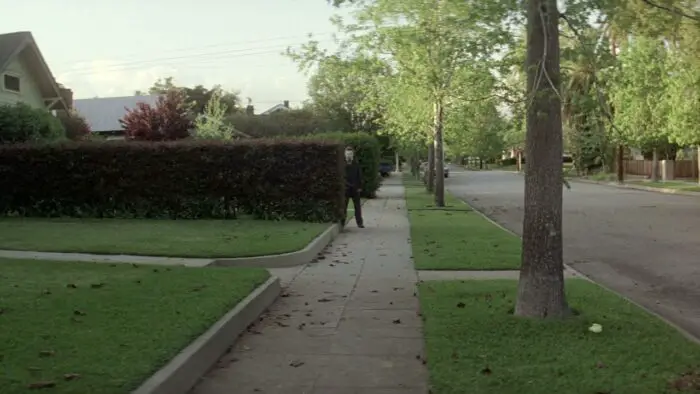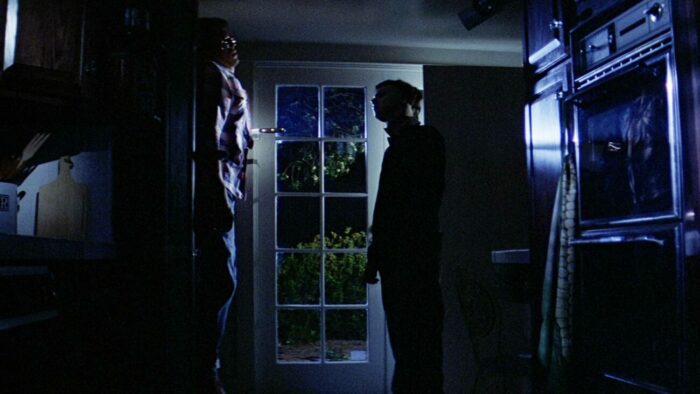Editor’s note: All throughout October, the vibes get spookier and the nights get longer. It’s the perfect time of year to watch horror movies, whether you’re a year-round horror fan or you just like to watch horror flicks to get into the Halloween spirit. This year at Horror Obsessive, for our 31 Horror Classics Revisited series, we’re giving you one recommendation for a classic horror film each day throughout the month of October. What do you think–is this film a horror classic? What other horror films do you consider to be classics, and what films do you make sure you watch each October? Let us know in the comments below!
Now, before you start calling for my head: yes, I am fully aware that Halloween (1978) was far from the first slasher film—that honor is somewhat debated, but generally considered to either be Psycho or Black Christmas. Nor is it the first film in the ever nebulous category of “iconic” slashers—that would be The Texas Chain Saw Massacre, coming out a good four years prior to Halloween.
I think I’ve maybe drafted and redrafted my thoughts on Halloween (1978) about a dozen times or so between the time I first sat down at my computer to type this article up and the time of actually submitting the damn thing. There’s…a lot that one can talk about with Halloween (most of it showing up in earlier drafts of this article!): how it turned a bunch of good ideas from early, almost prototypical slashers into what more or less became the blueprint for the slasher film, how for many, many years it was the most financially successful independent film period, how it almost singlehandedly kickstarted the slasher craze of the ’80s…but nothing felt right.
Thankfully for my sleep schedule, by about the twentieth draft of this article, I finally got to the heart of things: that while things like the film’s legacy and its impact are certainly important, at the end of the day what really matters about Halloween is that it was, is, and always will be one hell of a film. What John Carpenter, Debra Hill, Jamie Lee Curtis, and a whole number of talented collaborators created in 1978 wasn’t just the story of Michael Myers and Laurie Strode that would take the world by storm, it was—to borrow a comparison I read about the film many years ago—the slasher film’s equivalent of The Godfather: a film always imitated but never equaled.
To this day, Halloween (1978) is still the benchmark by which I inevitably wind up judging every other slasher I see, and even after seeing it at least twenty-some odd times, I don’t think it’s lost a single ounce of its power. It’s not so much a question of what it is about Halloween that keeps me coming back after all this time, but more a question of where do I start.
What stands out the most about Halloween nowadays, especially when compared to its own sequels, is how restrained it is. While the genre would very quickly embrace gore and increasingly ridiculous kills, Halloween almost entirely eschews that in favor of building tension to nearly unmatched heights to the point that you’re practically gaslit into thinking that you’re seeing Michael Myers everywhere. By the time night falls in Haddonfield and Michael is on the prowl, suddenly you start doing exactly what Dr. Sam Loomis warns us about, seeing him on every street corner and looking for him in every house.

Speaking of Sam Loomis, Donald Pleasance’s character is just one of many iconic characters that form the heart and soul of Halloween (1978). He might be named for Marion Crane’s boyfriend from Psycho, but he instead feels like a rebuttal to the psychoanalyst at the end of that film. Whereas that character in Psycho offered audiences a sense of comfort in his explanation of Norman Bates and his atrocities, Loomis exists almost solely to serve as a form of discomfort for the audience.
We crave the comfort of any sort of explanation for Michael Myers and the murders he commits—no matter how heinous that explanation might be—but none exists. The one guy who should be keeping calm, who should know what’s going on in Haddonfield, is instead one of the few people we meet who’s honest to god terrified at the idea of Michael’s return because there’s simply so much he doesn’t know. When Laurie, having barely escaped the clutches of a monster, asks Loomis if it was the Boogeyman, all he can say is “as a matter of fact, it was,” because he has no better answer for her.
Whatever you call him—Michael Myers, The Boogeyman, The Shape—the monster that stalks Laurie and her friends on Halloween night more than earns his place among the great monsters of horror in his first outing. He’s an enigma: an almost childlike curiosity mixed with a mechanical sense of killing, a flesh-and-blood man who has an almost supernatural ability to disappear as soon as he’s out of frame. There might not be much in terms of discernable motive for what he does, but there’s certainly some matter of method to his madness.
The movie that Laurie and the kids she babysits are watching in Halloween (1978) is the classic The Thing From Another World, and between Michael’s iconic mask and the almost supernatural way he glides through the frame—the camera gliding right along with him—one wonders if he, in turn, is something not of this world simply putting on a human face. My single favorite shot in all of cinema is the iconic hallway sequence, and one has to wonder if what we see in that shot is Michael emerging out of hiding or The Shape manifesting from the darkness itself.

And last but by no means least, there’s Laurie Strode, brought to life by the one and only Jamie Lee Curtis. Curtis—with no small amount of help from Debra Hill—gives Laurie a sense of realness that is still all too rare in so-called “final girls.” It’s not the actually-going-through-hell performance that Marilyn Burns turned in for The Texas Chain Saw Massacre, but the result is a more grounded, more authentic character. Laurie feels like a real person, and a big part of why Halloween resonates so strongly with us to this day is that she’s someone we can both empathize and connect with.
We feel everything Laurie feels: her embarrassment, her apprehension, and above all else, her fear. Good god, do we feel her fear. The terror found in Halloween is of a raw, almost primal variety, with Michael Myers representing not only the monsters of our childhood brought to life but a monster born from the haunted house stories seemingly found in every American suburb and small town.
But what ties everything together for Halloween is ultimately two people: writer-director John Carpenter and writer-producer Debra Hill. Hill’s dialogue, drawing from her own experience babysitting as a teenager, gives some rarely seen authenticity to Laurie and her friends while Carpenter directs the film with near Hitchcock levels of precision—not to mention giving the film its iconic score.
Of extra importance is the approach that Carpenter and Hill took when making Halloween: where The Texas Chain Saw Massacre was a film seemingly made for the grindhouse and drive-in circuit, Halloween was clearly made with mainstream audiences in mind, and…it worked. Halloween turned a roughly $300,000 budget into a $70 million worldwide box office and as I already mentioned more or less was what kicked off the slasher craze of the ’80s. Without the success of Halloween, we likely don’t get Friday the 13th, A Nightmare on Elm Street, or any of the other juggernauts of the genre. Without Halloween, many of my favorite films likely don’t get made—or if they do, they’d likely be almost unrecognizable.
But, no matter how many slashers I might see, Halloween (1978) is the one that I keep coming back to again and again. It’s the film that people have spent almost 45 years chasing, and is truly the one that started it all.



